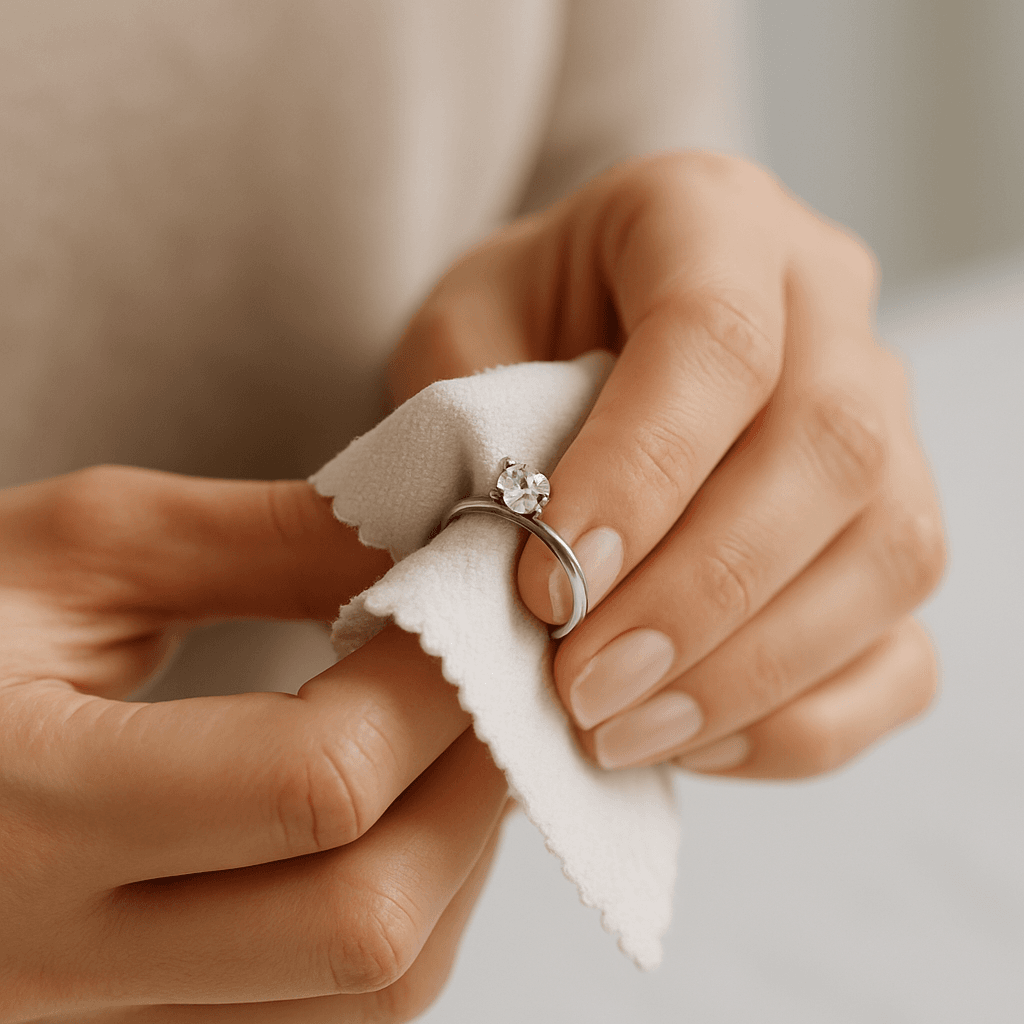Have a question? Contact us.
Email Us
Business Hours
Jewelry Care & Early Warning Signs: How to Preserve Your Pieces—and When to See a Pro in Fort Lauderdale
Your jewelry works hard every day. From sunscreen and soaps to workouts and ocean air, normal life can dull finishes, loosen stones, and weaken tiny metal components. A smart care routine protects the pieces you love and helps you spot issues early—before they become costly repairs. If you notice any of the warning signs below, it may be time to schedule professional jewelry repair in Fort Lauderdale at Luna Jewelers.
Daily Habits That Keep Jewelry Looking Its Best
Remove jewelry before working out, cleaning, yardwork, or swimming. Chemicals, perspiration, and impact are the three fastest ways to damage settings and finishes. Put pieces on last when getting ready and take them off first at night; lotions, hairsprays, and perfumes leave residue that dulls stones and can weaken adhesives used in certain designs. Create one consistent safe spot—a small tray or dish—near the places you usually remove jewelry so items don’t end up in a pocket, gym bag, or sink.

The Right Way to Clean at Home
Most diamond and sapphire jewelry responds well to a simple routine: a small bowl of warm water, a drop of mild dish soap, and a soft brush. Gently scrub under prongs and inside galleries where buildup hides, then rinse and pat dry with a lint-free cloth. Avoid harsh chemicals, silver dips, ultrasonic gadgets, and abrasive cloths unless a jeweler has confirmed your piece can handle them. Heat, vibration, and strong solutions can damage or loosen certain stones, plating, glues, and vintage details.
Care Tips for Watches
Watches deserve a quick care routine, too: wipe the case and crystal with a soft cloth after wear, rinse with fresh water after beach or pool time, and avoid extreme heat, steam, or chemicals that can degrade gaskets and finishes. Keep crowns fully pushed in or screwed down, and take the watch off for impact-heavy activities to protect the movement. If it starts running slow or fast, it may be magnetized or due for service. Leather straps prefer dry, cool storage; metal bracelets benefit from occasional gentle cleaning to remove sweat and grit that accelerate wear. Quartz models typically need a fresh battery every 1–3 years; replacing the battery is the perfect time to pressure-test water resistance and renew seals. Regular checkups catch loose pins, worn clasps, and early moisture signs before they become costly repairs.
Storage That Prevents Scratches and Tangling
Store pieces separately so harder gems don’t scratch softer ones. A fabric-lined organizer with individual compartments is ideal. Use anti-tarnish pouches or strips for sterling silver. Hang necklaces to prevent knots and kinked chains, and close clasps before you store them so fine chains don’t snag. For pearls and porous gemstones, keep them away from excessive dryness and chemicals, and plan on periodic restringing.
Early Warning Signs Your Jewelry Needs Professional Attention
Prongs catch on clothing. That snag likely indicates a worn or lifted prong—which can lead to a lost stone. If a prong feels sharp or you can feel a stone move with your fingernail, it’s time for inspection and prong re-tipping.
Rings spin or feel loose. If your ring suddenly rotates more than usual, the shank may be thinning or the size may no longer be accurate. A quick fit check prevents uneven wear and keeps the top aligned.
Chains look stretched or misshapen. Elongated links and stiff kinks indicate metal fatigue. This often precedes a break, especially on thin chains or bracelets worn daily.
Clasps fail intermittently. Clasps that close but don’t firmly hold are a risk. Springs wear out and connection points can open; a clasp repair or replacement is straightforward and prevents loss.
Gemstones look tilted or misaligned. If a stone sits crooked or seems deeper on one side, the seat or channel may be wearing. Early correction protects both the stone and the setting.
White gold looks yellowed. Rhodium plating on white gold naturally wears with time. Re-plating restores the bright white finish and can be paired with polishing and prong checks.
Pearls hang unevenly or the strand feels loose. Traditional silk stretches. If knots are uneven or you can slide pearls easily, schedule a restring to prevent breakage.
Earrings feel insecure. Backs stretch, posts bend, and settings loosen. If you can twist an earring in its mount or the back doesn’t grip, address it before the piece drops.
Common Causes of Damage (and How to Avoid Them)
Chemicals and saltwater. Chlorine, bleach, sunscreen, and ocean water corrode metal alloys and dull stones. Rinse pieces after beach days and keep them out of pools and hot tubs.
Hard knocks and repetitive stress. Lifting weights, rock climbing, and even keyboarding with heavy bracelets can stress delicate parts. Remove jewelry before activities that create repetitive contact.
Improper storage. Throwing multiple pieces into one pouch leads to scratches and tangles. Use separate compartments and soft surfaces.
Deferred maintenance. Small issues become big ones when ignored. A loose prong now is a replacement diamond later. Periodic checks are faster and more affordable than major restorations.
A Seasonal Care Calendar You Can Actually Follow
Every month: Give daily-wear pieces a quick soak and soft-brush clean, then pat dry. While drying, do a simple wiggle test on center stones and check clasps for crisp closure.
Every three months: Inspect prongs and galleries under bright light. Look for flattened tips, rough edges, or light gaps under stones. For bracelets and chains, roll them between your fingers—stiffness or clicking means a link or pin needs attention.
Every six months: Schedule a professional inspection and cleaning. A jeweler will test stone security, evaluate wear on prongs and channels, check solder seams, and polish safely. White gold items can be evaluated for rhodium re-plating.
Every year: Restring pearl strands you wear often, assess ring fit as seasons change, and review any pieces with sentimental or monetary value to keep them insured properly and in good condition.
When to Seek Professional Service Immediately
You hear a tiny rattle when you shake a ring next to your ear. That suggests a stone is moving in its seat. Stop wearing it and have it tightened.
A chain has a visible crack or an open jump ring. Metals fatigue at stress points; one more tug could break the piece. Repair the weak link before wearing again.
A ring catches frequently on fabrics or hair. That prong is likely raised or thinning. A quick re-tipping and polish prevents a lost stone.
You see discoloration on white gold. Rhodium plating is wearing away. Re-plating restores color and adds a protective surface.
Pearl knots are uneven or dirty. Restring before the strand stretches further or snaps.
Fort Lauderdale Factors That Matter
Local life can be hard on jewelry. High humidity and frequent beach time mean more exposure to salt, sand, and sunscreen. If your routine includes the ocean, boating, or pool time, clean and rinse your jewelry afterward and plan more frequent inspections. Living near Las Olas, Victoria Park, or Wilton Manors often means a lot of day-to-night wear; consider a small travel case so pieces stay protected when you’re on the move.
Professional Services That Keep Jewelry Safe for the Long Term
Prong re-tipping and stone tightening. Reinforces worn tips and protects settings, especially for daily-wear rings.
Chain soldering and clasp repair. Restores strength and smooth operation, preventing accidental loss.
Rhodium plating for white gold. Renews bright whiteness and provides a protective layer.
Shank reinforcement and resizing. Corrects fit and strengthens thin or worn rings so they sit upright and wear evenly.
Professional polishing and ultrasonic cleaning. Removes buildup and restores shine without harming stones or settings when done correctly.
Stone replacement and matching. If a stone is lost or damaged, an expert match and precise re-setting preserves the look and value of the piece.
Neighborhoods We Serve: Las Olas, Victoria Park, Wilton Manors and all surrounding Fort Lauderdale communities.

